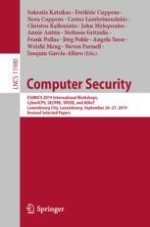This book constitutes the refereed post-conference proceedings of the 5th International Workshop on Security of Industrial Control Systems and Cyber-Physical Systems, CyberICPS 2019, the Third International Workshop on Security and Privacy Requirements Engineering, SECPRE 2019, the First International Workshop on Security, Privacy, Organizations, and Systems Engineering, SPOSE 2019, and the Second International Workshop on Attacks and Defenses for Internet-of-Things, ADIoT 2019, held in Luxembourg City, Luxembourg, in September 2019, in conjunction with the 24th European Symposium on Research in Computer Security, ESORICS 2019.
The CyberICPS Workshop received 13 submissions from which 5 full papers and 2 short papers were selected for presentation. They cover topics related to threats, vulnerabilities and risks that cyber-physical systems and industrial control systems face; cyber attacks that may be launched against such systems; and ways of detecting and responding to such attacks.
From the SECPRE Workshop 9 full papers out of 14 submissions are included. The selected papers deal with aspects of security and privacy requirements assurance and evaluation; and security requirements elicitation and modelling and to GDPR compliance.
The SPOSE Workshop received 7 submissions from which 3 full papers and 1 demo paper were accepted for publication. They demonstrate the possible spectrum for fruitful research at the intersection of security, privacy, organizational science, and systems engineering.
From the ADIoT Workshop 5 full papers and 2 short papers out of 16 submissions are included. The papers focus on IoT attacks and defenses and discuss either practical or theoretical solutions to identify IoT vulnerabilities and IoT security mechanisms.
